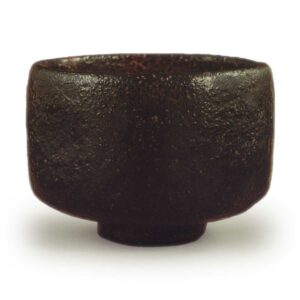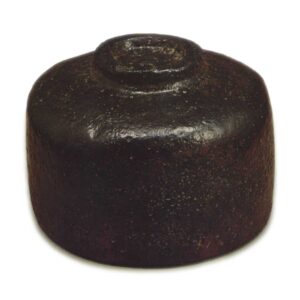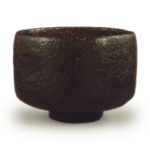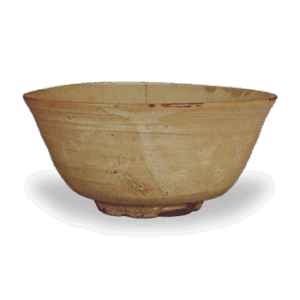

Daimyo-mono
Height: 8.3cm
Diameter: 10.6-10.7cm
Outer diameter of foot ring: 4.7cm
Height of foot ring: 0.8cm
The origin of the name “Kitano” is somewhat unclear, but the “Fushimiya Kakusho” (Fushimiya Memorandum) states “Kitano Kuro, made by Chojiro, owned by Rikyu, used at the Kitano Grand Tea Ceremony”, and judging from the fact that Zuiryusai wrote “Kitano Kuro” on the lid of the inner box, we can assume that the origin of the “Fushimiya Kakusho” is reliable. The appearance is that of a small, modest, and gentle-looking tea bowl, with a rather thick body but a considerably thinly pared-down base.
The gently bulging body is slightly constricted in some places, and the rim is turned inwards.
The foot ring is high and clearly carved, giving the bowl a modest and tightly-knit appearance, which is a characteristic of this type of tea bowl. The headband is small, and the area around it is carved roundly.
The black glaze is quite thick and well-dissolved. However, it is a pity that the glaze is not as smooth as that of Daikoku or Shunkan, but is quite rough, perhaps because it was removed from the kiln at the wrong time. The characteristic brown glaze appears in the black glaze, but the inside is quite thin and has a strong brown taste. There are four marks on the foot ring. There is a large crack on the body, which has been repaired with lacquer.
On the back of the inner box lid, there is a note in the handwriting of Esan, which reads “Rikyu’s seal is in the box. I have not seen it yet. Black tea bowl. Left (signature)”, and a letter with the text on the left is attached regarding this Rikyu’s seal.
As you were here yesterday, I hope you will not be too disappointed that you did not see the calligraphy box or the black tea bowl. I am sorry, but I will write a letter and send it to you. I will send you both colors. Please accept this box of tea that has come from Uji. I am very sorry to trouble you. December 9th
Furthermore, this morning, the people from the Takeuchi family came to see me. If you have time, please come and see me.
Please give this to Kōzen’in-sama.
When Esan once saw the Kitano Kuro, there was a seal of Rikyū on it, but now it has disappeared and he regrets that it is no longer visible, and so he wrote the inscription on the box.
On the same inner box lid, Zuiryūsai Sōsa wrote the inscription “Kitano Kuro, Kōzen’in, inner old father’s letter, Sōsa (signature)”. Furthermore, on the lid of the outer box, there is a note by Josai Sosai, with the two characters “Kitano” on the front and “Kitano Kuro Chojiro Chawan Aigen-sai Bun-soe Zuiryu-sai Kiwami Joshin Sosa (signature)” on the back.
After being in the possession of Rikyu, it was passed on to Kozen-in, and later came into the possession of the wealthy merchant Fuyuki of Edo (Ueda Kiheiji), and then, during the Kansei era, it came into the possession of Matsudaira Kaimori, and then, during the Bunka era, it came into the possession of the Edo dealer Sokyoku and Goryo, and then it came into the possession of Matsudaira Fumai. The price was 350 ryo.
Lord Fumai valued the tradition that it was used at the Kitano Grand Tea Ceremony, and he took particular care of the Chojiro tea bowl in his collection, and in the “Unshu Meibutsu Ki” (Record of Famous Unshu Tea Bowls) it is listed in the section on famous tea bowls, and is treated on the same level as the Kizaemon well, the Hosokawa well, the moth-proof lid, the oil spot, and the Kaga well. In December 1809, a tea ceremony was held using these bowls, and the main utensils used were as follows.
- Hanging scroll: “Rikyu-mon” (Rikyu-style)
- Tea caddy: “Fukiko”
- Tea bowl: “Kitano-kuro”








